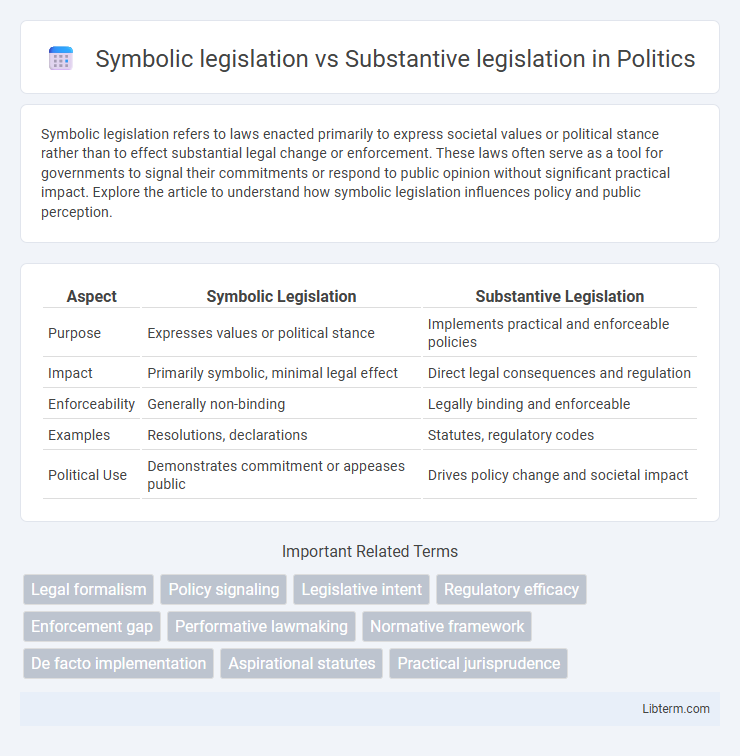Symbolic legislation refers to laws enacted primarily to express societal values or political stance rather than to effect substantial legal change or enforcement. These laws often serve as a tool for governments to signal their commitments or respond to public opinion without significant practical impact. Explore the article to understand how symbolic legislation influences policy and public perception.
Table of Comparison
| Aspect | Symbolic Legislation | Substantive Legislation |
|---|---|---|
| Purpose | Expresses values or political stance | Implements practical and enforceable policies |
| Impact | Primarily symbolic, minimal legal effect | Direct legal consequences and regulation |
| Enforceability | Generally non-binding | Legally binding and enforceable |
| Examples | Resolutions, declarations | Statutes, regulatory codes |
| Political Use | Demonstrates commitment or appeases public | Drives policy change and societal impact |
Introduction to Symbolic and Substantive Legislation
Symbolic legislation refers to laws enacted primarily to express societal values or political ideals without imposing significant practical effects, often serving as a tool for public communication. Substantive legislation, in contrast, enforces concrete rights, duties, and regulations that directly affect behavior and legal outcomes. Understanding the distinction between symbolic and substantive legislation is essential for analyzing law's role in shaping social norms versus regulating actions.
Defining Symbolic Legislation
Symbolic legislation refers to laws enacted primarily to convey values, ideals, or political statements without significant practical impact or enforcement mechanisms. This type of legislation often serves to express societal attitudes or government positions on issues rather than to regulate behavior or produce tangible legal outcomes. The key characteristic of symbolic legislation lies in its emphasis on symbolism and public messaging rather than substantive legal change.
Understanding Substantive Legislation
Substantive legislation defines rights, duties, and obligations that directly affect individuals' legal relationships and societal conduct, providing clear and enforceable rules. It contrasts with symbolic legislation, which primarily serves expressive or declarative purposes without substantial legal impact. Understanding substantive legislation is crucial for interpreting the practical legal effects and ensuring compliance with established legal standards.
Key Differences Between Symbolic and Substantive Laws
Symbolic legislation primarily serves to express societal values or political stances without imposing significant legal obligations or penalties, while substantive legislation creates actionable laws that directly regulate behavior and establish enforceable rights and duties. Symbolic laws often lack detailed enforcement mechanisms and are intended to convey moral or ethical messages, whereas substantive laws contain clear provisions, penalties, and procedures essential for legal compliance and adjudication. The key differences lie in their practical impact, enforcement rigor, and the intentionality behind their adoption--symbolic laws emphasize representation and public sentiment, whereas substantive laws focus on concrete regulatory outcomes.
Historical Examples of Symbolic Legislation
Symbolic legislation often serves to express societal values or political ideals without enforcing significant legal change, as demonstrated by the U.S. Civil Rights Act of 1957, which primarily symbolized federal commitment to civil rights despite limited practical enforcement. The Canadian Multiculturalism Act of 1988 exemplifies symbolic legislation by officially recognizing cultural diversity without imposing regulatory consequences. Historical examples highlight how symbolic laws can influence public sentiment and national identity while lacking substantial legal impact.
Impact of Substantive Legislation on Society
Substantive legislation directly shapes social behavior by establishing clear legal rights and obligations, thereby ensuring justice, fairness, and societal order. It impacts everyday life by regulating critical areas such as employment, education, health, and civil rights, fostering stability and public trust in legal systems. Unlike symbolic legislation, substantive laws provide enforceable standards that drive meaningful social change and protect individuals from abuses.
Political Motivations Behind Symbolic Laws
Symbolic legislation often serves political motivations by signaling commitment to certain values or ideologies without creating substantial legal change, aiming to enhance public image or appease specific voter groups. These laws typically lack rigorous enforcement mechanisms, focusing instead on generating political capital or placating interest groups, contrasting with substantive legislation that enacts concrete legal obligations and policy shifts. Politicians use symbolic laws to shape public discourse and reinforce identity politics, leveraging symbolism over practical impact to influence electoral outcomes and maintain power.
Challenges in Implementing Substantive Legislation
Implementing substantive legislation faces challenges such as the complexity of enforcing detailed legal requirements, often resulting in significant administrative burdens and resource constraints for regulatory agencies. The ambiguity in interpreting substantive provisions can lead to inconsistent application across jurisdictions, undermining legal certainty and compliance. Resistance from stakeholders affected by substantive regulations may also hinder effective enforcement and necessitate continuous monitoring and revisions.
Evaluating Effectiveness: Symbolic vs Substantive Approaches
Evaluating the effectiveness of symbolic versus substantive legislation requires analyzing their impact on policy outcomes and societal behavior. Symbolic legislation primarily serves to signal political values or respond to public sentiment without creating enforceable change, often leading to minimal practical effects. Substantive legislation, conversely, establishes concrete rules and mechanisms that drive measurable social improvements and legal accountability, thereby offering greater long-term effectiveness in addressing complex issues.
Future Implications for Lawmaking and Policy
Symbolic legislation often serves as a communication tool reflecting societal values without immediate legal impact, potentially shaping future public opinion and policy agendas. Substantive legislation establishes concrete legal obligations and rights, directly influencing societal behavior and institutional operations. Future lawmaking may increasingly balance symbolic acts to signal commitment and substantive rules to drive tangible change, leveraging both for responsive and adaptive governance.
Symbolic legislation Infographic

 libterm.com
libterm.com